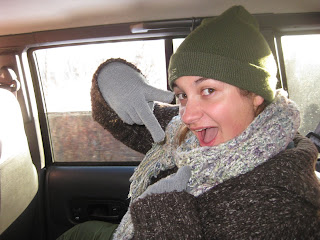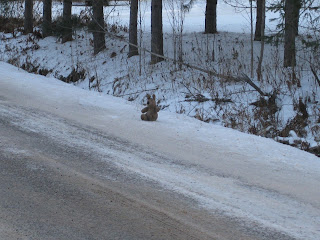I took a Saturday off of Feeder Watch and participated in the annual Christmas Bird Count (CBC) in the Duluth area. I rode along with an astute team comprised of: Hawk Ridge Educators Debbie Waters and Sarah Glesner and Hawk Ridge Enthusiast and Bird Whisperer Andrew Longtin. We started early, and I miraculously made it out of bed at 5AM in order to meet my team in Duluth. For those that are not privy to Christmas Bird Count, it is an international citizen science project where bird enthusiasts and their friends and family garner winter bird population data. The data collected will be added to historical records and then analyzed for trends in populations that can then be used to make conservation decisions. For more details about CBC check out: http://www.audubon.org/Bird/cbc/
My group was a lively bunch, a must in a Minnesota winter birding event. We dressed in our warmest 'quiet' gear (mainly fleece and wool, no swishy materials, see Sarah's below left) and headed out around 7:30AM.


Our region mostly comprised of residential area, the luxurious Duluth Airport, the Duluth Mall, and various woodlots. The most common bird observed was the Black-capped Chickadee (see above right); however we had some less common birds as well like the Cedar Waxwing, Barred Owl, and Brown Creeper. My birding highlights included:
(1) Flushing out a very irritated Barred Owl, because we had phished in a cluster-fuck of Black-capped Chickadees
(2) +/- 150 mixed flock of Cedar Waxwing and Bohemian Waxwings enjoying the berries that covered the Mountain Ash
(3) Spotting an adult Bald Eagle in the Duluth Mall Area at 14:10
(4) The Brown Creeper doing what it does best, creeping slowly head first around a lichen covered tree
My favorite non-bird specific highlights included:
(1) The teddy bear Hit-N-Run, who may or may not become a Hawk Ridge Mascot

(2) Andrew's premonitions about the birds we would see. i.e. A Swainson's Thrush and/or Tree Sparrow being flushed out by a late migrating Northern Harrier being acutely watched by a Great Gray Owl
(3) Debbie and Sarah's vocal imitations of many comedic acts
Overall, though my toes are still thawing out, I enjoyed my first CBC. Here are my team's results:
| Species | Zone O | Zone N |
| Cooper’s Hawk | 1 | 0 |
| Bald Eagle | 0 | 1 |
| Mourning Dove | 2 | 0 |
| Rock Pigeon | 0 | 4 |
| Barred Owl | 1 | 0 |
| Downy Woodpecker | 5 | 9 |
| Hairy Woodpecker | 4 | 1 |
| Pileated Woodpecker | 0 | 1 |
| Blue Jay | 5 | 2 |
| American Crow | 8 | 22 |
| Common Raven | 3 | 0 |
| Black-Capped Chickadee | 116 | 82 |
| Red-breasted Nuthatch | 7 | 6 |
| White-breasted Nuthatch | 2 | 3 |
| Brown Creeper | 0 | 1 |
| American Robin | 2 | 27 |
| Cedar Waxwings | 0 | 150 |
| Bohemian Waxwings | 16 | 8 |
| Northern Cardinal | 1 | 2 |
| European Starling | 4 | 169 |
| Purple Finch | 1 | 0 |
| Dark-eyed Junco | 0 | 7 |
| White-winged Crossbill | 26 | 35 |
| American Goldfinch | 15 | 0 |
| House Sparrow | 0 | 27 |







 Sparrows soon. One of the White-breasted Nuthaches bore a small grey bird band. I suspect it was one that was banded here at Audubon, but I did not have the time to read the numbers.
Sparrows soon. One of the White-breasted Nuthaches bore a small grey bird band. I suspect it was one that was banded here at Audubon, but I did not have the time to read the numbers. 
 It was a cold January morning in Petersburg, Pennsylvania, abnd I was receivinga crash course in common winter birdfeeder birds. Although it was not until 3 months later that I became enthralled with ornithology and the joys of bird-watching, I will never forget the excitement of watching a white-breasted nuthatch flying back and forth between a feeder and a tree on that bugar-freezing day. At the time, I pondered why the nuthatch ate that way when other birds chose to eat their seeds right at the feeder. Why did the nuthatch use up all that energy going back and forth? Since then I have become a birder, I find the august song of a winter wren or a sneak-in visit by a hermit thrush to be tantamount to or exceed any experience I have had at a zoo or circus. In agreement with me would likely be Marie Winn.
It was a cold January morning in Petersburg, Pennsylvania, abnd I was receivinga crash course in common winter birdfeeder birds. Although it was not until 3 months later that I became enthralled with ornithology and the joys of bird-watching, I will never forget the excitement of watching a white-breasted nuthatch flying back and forth between a feeder and a tree on that bugar-freezing day. At the time, I pondered why the nuthatch ate that way when other birds chose to eat their seeds right at the feeder. Why did the nuthatch use up all that energy going back and forth? Since then I have become a birder, I find the august song of a winter wren or a sneak-in visit by a hermit thrush to be tantamount to or exceed any experience I have had at a zoo or circus. In agreement with me would likely be Marie Winn.
